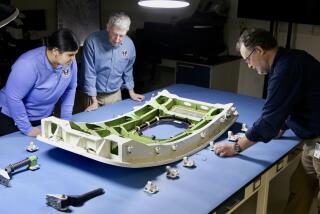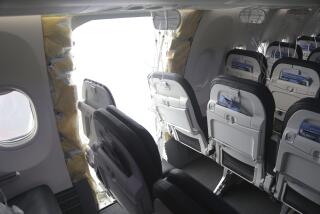Tail Fin Flaw Alarms Safety Experts
- Share via
WASHINGTON — Investigators probing the crash of American Airlines Flight 587 in November said Monday that they have found internal damage in the tail fin of another Airbus A300 jet, raising questions about the visual inspections used to certify the safety of the planes.
Responding to the findings by the National Transportation Safety Board, the Federal Aviation Administration said that it will require the tail fins of A300s that have encountered severe in-flight stress to be inspected with ultrasound techniques capable of detecting internal flaws.
Investigators said they hope the new procedures will yield more information on the performance of the material used to construct the tail fins, a composite of many layers of carbon fiber embedded in a special resin and molded together under heat and pressure.
Flight 587 crashed Nov. 12 in New York, killing all 260 people aboard and five others on the ground. The safety board is trying to determine whether design or structural problems, a mistake by the pilots, or some combination of factors caused the plane’s 27-foot tail fin to snap off, making it impossible to control.
Last month, the safety board warned that pilots can unwittingly over-stress the tail fin of any aircraft by making sharp back-and-forth movements of the rudder.
On Monday, the NTSB said that it will begin using CT-scan technology to examine the internal condition of Flight 587’s tail fin. Investigators are focusing on six attachment fittings used to connect the tail fin to the plane’s fuselage. One of those fittings had sustained internal damage during manufacturing, but it was repaired before the plane went into service.
The second damaged jet was an American Airlines A300 that encountered severe stresses during a 1997 flight, when it nearly stalled and then dropped about 3,000 feet before a landing in Miami. Investigators believe those stresses may have been similar to the conditions Flight 587 encountered.
Using ultrasound to peer into the interior layers of the composite material, investigators discovered that some were peeling apart. The flaw in the second jet was discovered in the right rear fitting that attaches to the plane’s fuselage.
Precautionary visual inspections of A300s after the Flight 587 accident had failed to find the flaw. Airbus Industrie, the European consortium that builds the planes, continues to recommend only a visual inspection of the tail fins every five years.
“Damaged tails are being found in aircraft other than Flight 587,” said Lee McKague, a veteran composites engineer. “The case for periodic ultrasonic inspection grows.”
The second jet has been taken out of service and will get a completely new tail fin, investigators said. FAA spokesman Les Dorr said that it was not yet clear how many other planes will have to be inspected with ultrasound.
“The way we are going to determine which aircraft are going to be inspected is by a review of their service histories, to see which ones have been exposed to upset or maneuver events,” Dorr said.
Airbus spokeswoman Mary Anne Greczyn said that the NTSB’s finding of internal damage on a second plane only strengthens the company’s argument that its design is sound. She noted that the plane has continued to fly safely for nearly five years since the incident.
“This is a plane that went through hell and lived to tell about it, in spades,” Greczyn said. She said Airbus still stands by visual tail fin inspections for aircraft that have been operating under normal circumstances.
But if the second plane survived a similarly severe stress, why didn’t Flight 587?
“That’s the million-dollar question,” Greczyn said. “If one stood up, then why didn’t the other?”
More to Read
Inside the business of entertainment
The Wide Shot brings you news, analysis and insights on everything from streaming wars to production — and what it all means for the future.
You may occasionally receive promotional content from the Los Angeles Times.










